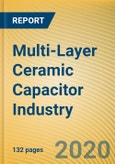As estimated, the world’s MLCC market was worth $12.8 billion in 2018, surging by 21.9% on annualized basis. In 2025, the global MLCC market size will be up to $24 billion in pace with advances in communication standards and the popularization of new energy vehicle
Electronic components like MLCC enjoy a rosy prospect alongside the burgeoning electronic manufacturing, the thriving internet and the prevalence of smart hardware.
MLCC was much sought after and its price kept rising worldwide in the first three quarters of 2018 as the global MLCC capacity structure changed and the robust demand from new applied markets of terminals grew substantially. Entering the fourth quarter of 2018, MLCC price fell a bit due to the Sino-US trade frictions, the decreasing demand for consumer electronics like smartphone's, among others. As estimated, the world’s MLCC market was worth $12.8 billion in 2018, surging by 21.9% on an annualized basis. In 2025, the global MLCC market size will be up to $24 billion in pace with advances in communication standards and the popularization of new energy vehicle.
China is not only the key manufacturing base for global consumer electronics but also the world’s largest producer and consumer of MLCCs. Spurred by strong demand from downstream industries, Chinese MLCC market is enlarging from RMB67.353 billion (up 21% YoY) in 2018 to expectedly RMB130.015 billion in 2025.
MLCC mainly finds application in such fields as consumer electronics, automotive electronics, industry/IoT/security, and military electronics. Noticeably, 64.2% of MLCCs get used in consumer electronics, accompanied by the rising share of MLCC use for new energy vehicle from 11.2% in 2018 to an estimated 19.3% in 2025 as new energy vehicle springs up.
The world-renowned MLCC vendors come mainly from Japan, South Korea and Taiwan (China) and they are divided into three echelons. The giants including Murata, Samsung Electro-Mechanics, TDK, Taiyo Yuden, and Yageo stay ahead of other peers by superiorities in ceramic powder materials and manufacturing technologies. Japanese players are in supremacy in small high-capacity and ceramic powder technologies and boast complete product matrices. The competitors from Taiwan (China), South Korea and the United States have their own edges, while the Mainland Chinese counterparts are in the third echelon.
Starting from 2017, Japanese and Korean MLCC tycoons have been pushing ahead with industrial upgrading and gearing towards small high-end capacitors with high capacity. The global under-capacity of MLCC caused MLCC price to rise ever in 2018, alluring key companies like Murata, Samsung, Yageo and Taiyo Yuden to lavish huge capital in capacity expansion successively. It is expected that global MLCC capacity will reach 6,100 billion units per year in 2025 and the tight supply will be eased then.
Global and China Multi-layer Ceramic Capacitor (MLCC) Industry Report, 2019-2025 highlights the following:
- MLCC market (size, production & sales, demand, capacity and competitive pattern);
- MLCC market segments (military, industrial, consumer electronics, automotive electronics);
- Upstream sectors;
- 8 foreign and 7 Chinese MLCC companies (operation, products, etc.).
This product will be delivered within 3-5 business days.
Table of Contents
Companies Mentioned
- Beijing Murata Electronics Co., Ltd.
- Chaozhou Three-circle
- Dongguan Samsung Electro-Mechanics Co., Ltd. (DSEM)
- Dongguan Taiyo Yuden Co., Ltd.
- Dongguan Walsin Technology Electronics Co., Ltd.
- Fenghua Advanced Technology
- Holy Stone
- KEMET
- KYOCERA
- Murata
- Nippon Chemi-Con
- Samsung Electro-Mechanics
- Samsung Electro-Mechanics Co., Binhai Branch Factory
- Samsung Electro-Mechanics Co., Suzhou Branch Factory
- Samwha Electric
- Shanghai KYOCERA Electronics Co., Ltd.
- TDK
- TDK Xiamen Co., Ltd.
- Taiyo Yuden
- Tianjin Samsung Electro-Mechanics Co., Ltd. (TSEM)
- Tianjin Samwha Electric Co., Ltd.
- Tianli Holdings Group Limited
- Torch Electron
- Walsin Technology
- Wuxi Murata Electronics Co., Ltd
- Yageo
- Yageo Electronics (China) Co., Ltd.
Methodology

LOADING...








